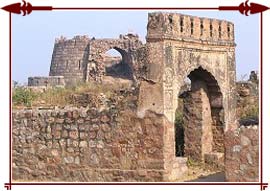| Constructed By | Ghiyas-ud-Din Tughlaq |
| Year of Construction | 1321-25 |
| Location | Near Qutab Minar Complex, on the Qutab-Badarpur Road |
 Tughlaqabad Fort, perched on a rocky hill, constitutes one third of the capital city of India. The fort is located on the Qutab-Badarpur Road and was built by Ghiyas-ud-Din Tughlaq, the founder of the Tughlaq dynasty. The Tuglaqabad Fort seems to be more or less octagonal, with a border of approximately 6.5-km. The ramparts of the fort, now in ruins, are between 10m to 15m high with fortresses and gateways at intervals. The Tughlakhabad at Delhi was built to serve a dual purpose, one of providing a defensive structure to the ruler and the second, to serve as his imposing capital.
Tughlaqabad Fort, perched on a rocky hill, constitutes one third of the capital city of India. The fort is located on the Qutab-Badarpur Road and was built by Ghiyas-ud-Din Tughlaq, the founder of the Tughlaq dynasty. The Tuglaqabad Fort seems to be more or less octagonal, with a border of approximately 6.5-km. The ramparts of the fort, now in ruins, are between 10m to 15m high with fortresses and gateways at intervals. The Tughlakhabad at Delhi was built to serve a dual purpose, one of providing a defensive structure to the ruler and the second, to serve as his imposing capital. Tughlaqabad stands divided into three segments. The eastern segment is entered through from the Qutub-Badarpur road. It is a rectangular area enclosed within high walls and bastions and used to serve as the citadel. On the west side of the Tughlaqabad Fort is a wider area that once contained the palaces and is surrounded by walls and bastions. A huge reservoir stands on the southern side of the Tughlaqabad Fort at Delhi. Bunds were put up between hills to the east to create the reservoir, which is linked with Ghiyas-ud-Din's tomb through a causeway.
There is a wide mound near the south eastern-corner of the Fort Tughlakhabad of Delhi that leads to the fortress of Adilabad. The sluice gates near the mound were used for controlling water for irrigation purposes. There is also a tower, known as the Bijai-Mandal, inside the fort, along with remains of several halls, and also a long underground passageway. To the north of the fort, lies the city of Tughlaqabad, which is now mostly in ruins.
No comments:
Post a Comment
We are online tour operator based in India. Our main focus to provide information about Indian culture, heritage, wildlife, pilgrimage tours.Etc..